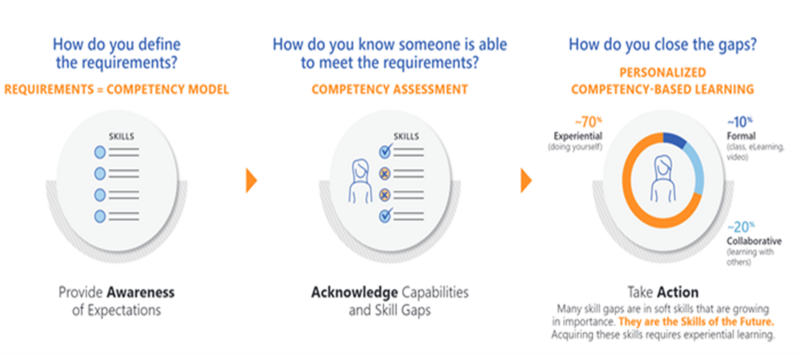ATD Blog
Ensure Upskilling and Reskilling Equity
Fri Oct 28 2022

Bookmark
In 2017, the World Economic Forum found that the half-life of a skill is five years. That means every five years our skills will be half as valuable as they are now. With the rapid digitization that occurred in 2020, that’s decreased to four years. Without upskilling or reskilling, there will not be enough skilled employees to do the jobs that exist.
To ensure that all employees have the ability to upskill and reskill so their skills don’t degrade over time, organizations need:
To be aware of the job requirements (current and future)
To analyze of whether employees meet those requirements
To identify actions they need to take to close current and future skills gaps
This diagram outlines the steps visually:

If only a subset of the people in your organization were provided with the ability to become aware of their requirements, analyze whether they meet those requirements, and receive personalized, competency-based learning to close skills gaps, that wouldn’t be fair.
While education can be the great equalizer in terms of socioeconomic status given equal access to educational resources, the same can be said for the workplace. As Manpower Group discovered in 2018, there’s a widening gap between the haves and the have-nots with respect to the right skills for today’s work. Those with the right skills will be able to increasingly control their destiny—choosing how, where, and when they work—while those without the required skills will not be able to envision how to improve their circumstances. We saw this dynamic play out during the pandemic, and the disparity between the haves and the have-nots is getting more severe.
How Organizational Infrastructure Contributes to Disparity
Many organizations provide a training content library in a learning management system (LMS), enabling access to a wide variety of skill development resources. But without personalization, these resources can be overwhelming, causing them to be underutilized, especially by the have-nots. Plus, a learning content library represents the 10 (formal learning) in the 70-20-10 learning framework. That means employees are getting access to content representing just 10 percent of how people learn. The other 90 percent of how we really learn (experiential and collaborative) is left out.
These same organizations have a personalized strategy for high potentials—people identified as future leaders. They get considerable assessment, guidance, personalized training, and mentorship that ensures experiences across the entire 70-20-10 spectrum. This provides some people with access to more growth opportunities than others—specifically the ones that most contribute to growth. If high potentials represent about 5 percent of the organization, that means 95 percent of the organization is left out.
Obviously in some organizations, historically underrepresented groups are less likely to be identified as high potentials. The high potential selection process is subjective and open to bias. Diverse employees are more likely to be part of the 95 percent without access to the best growth opportunities.
In other words, organizations that provide the full spectrum of personalized learning for a few and a content landfill of limited formal learning for the rest perpetuate the disparity between haves and have-nots. That’s not equity.
In the Harvard Business Review article, “Leadership Training Shouldn’t Just Be for Top Performers,” Navio Kwok and Winny Shen state, “Amid this war for talent that currently has no geographical limitations and is showing no signs of stopping, investing in the ‘rest’ ensures you have a strong bench and protects you from flight risk in the Great Resignation.”
Those that justify the divided learning strategy claim it’s not possible to scale personalization and access to 70-20-10 resources. At SkillDirector, we disagree.
Scaling Learning to Create Equity for All
To create a fair learning environment that encourages everyone to succeed, remember two things:
1. If you truly want to promote organizational equity, provide everyone with the opportunity to grow at their own pace.
2. You can’t scale personalization without technology.
There are actions you can take toward an equitable learning environment today. First, find a competency development system that allows every person to have access to detailed role requirements. This is not a job description, but the actual tasks and skills required, along with rich behavioral examples of what great looks like. In addition, let each person can assess themselves against their own role or any other role to see how they compare.
You also want to present each employee with personalized learning opportunities across the 70-20-10 model as a result of that assessment.
Experiential learning is the most powerful because one can apply it in the flow of work and get immediate feedback enabling them to adapt. Ensure these are accessible to the entire organization.
Collaborative learning enables connection between those who are strong in a task with those who need to grow. That develops the skills of both people. In a large organization, you can’t do that without a system that makes such connections easy. It also makes it easy to recognize and reward those who take advantage of it so that you build a collaborative culture.
Traditional formal learning (classroom, e-learning) is still supported, but may also be enhanced into experiential learning.
Each person can own and easily track their development history across 70-20-10 activities, including documenting everyday learning. Not only does this provide them with opportunities to grow at their own pace, it also provides them with better ways to use this data for their career, such as evidence for new projects and promotions.
It’s time to eliminate the disparity between haves and have-nots with respect to the right skills for work today and in the future. If you want to ensure upskilling and reskilling equity for all, leverage technology to provide everyone with the opportunities to grow at their own pace. Now, not everyone may take advantage of these opportunities. Equity isn’t about making everyone do something, but rather, providing them with the access and ability to do so.
More from ATD

